When you are planning your future, it is vital that you work out how much risk you are prepared to take on and when you are going to need access to the money you have invested. Remember, if you cannot afford to lose anything then you should not invest at all.
To preserve capital there are two factors that must be adhered to – diversification and liquidity. The first should prevent any sudden disasters within your portfolio, for example the bottom dropping out of the bond market, and the latter will allow you immediate access to cash. The obvious inference here as well is that equities can be deemed to be more volatile than other asset classes so you need time for them to perform to their optimum.
There are also some funds, mostly classified as Income, out there that split the investment process into what is known as Income and Accumulation Units. They do what they say, if you want regular access to your money then you will be put into Income Units, if you do not then your investment will be classified as Accumulation Units and any growth will be re-invested thus allowing the latter to grow more over the period of time you leave it in your portfolio. Most other funds do not offer an option on Income or Accumulation Units and not even offer the former as an alternative.
Returning to the issue of risk and reward, the basic premise is that if you are looking to make higher than average returns or even just beat the bank then you must be ready to take on a certain degree of risk. This then brings us on to how to classify certain asset classes. What I am about to do is not set in stone and certainly not the definitive answer to everything but is meant to give a broad outline to those investing for the first time.
Usually government bonds are looked at as being the least risky type of investment. However, as explained above, at the moment there are certain sovereign debts out there that I would not touch with a barge pole. Next comes such animals as multi-national corporate bonds, then those that are in such indices as S&P500, FTSE100, etc. These are then followed by the likes of smaller companies in developed markets and finally emerging ones. However, when you look offshore you should also be aware that you will be taking on currency exposure, so you should weigh this up as well. For those with a longer term outlook then you can start to consider bringing in other factors as well – such as equities, commodities, hedge funds, property and other alternatives.
The best way to do this is to divide up the aforementioned asset classes into geo-political and sectoral classes; for example, British financials. Now that you have decided what type of fund to invest in you need to find out more about the ones in your chosen field. There are many places to look. Personally, I like Trustnet but Citywire, Bloomberg and Morningstar are just as good. They will compare your chosen fund with a benchmark and you can also select other funds and do a performance comparison. When you do this please remember that it is not wise to look at the short term but also how the fund has performed over the years. This will then allow you to gauge the volatility as well as the performance. Consistency is what you are looking for and how managers have done in good times… and bad. The aforementioned fund selection sites will also give an independent view on how they rate the managers of the funds you would like to buy. This should also play a part in your final choice.
| The above data and research was compiled from sources believed to be reliable. However, neither MBMG International Ltd nor its officers can accept any liability for any errors or omissions in the above article nor bear any responsibility for any losses achieved as a result of any actions taken or not taken as a consequence of reading the above article. For more information please contact Graham Macdonald on [email protected] |




